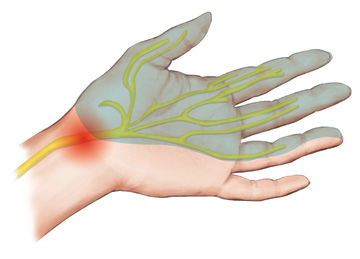Pregnancy—Carpal tunnel syndrome
What is pregnancy related carpal tunnel syndrome?
 Increased fluid and relaxation of the ligaments in the hand and wrist can cause pressure and compress the nerves and blood vessels of the carpal tunnel. This can cause numbness, tingling, stiffness or pain in the hand and wrist. These symptoms can range from mild to severe and can affect your ability to sleep and use your hands for everyday tasks such as shampooing your hair, fastening buttons, holding your toothbrush and looking after your new baby. In some cases this can cause weakness of the hand and you may have difficulty gripping or find yourself dropping items. .
Increased fluid and relaxation of the ligaments in the hand and wrist can cause pressure and compress the nerves and blood vessels of the carpal tunnel. This can cause numbness, tingling, stiffness or pain in the hand and wrist. These symptoms can range from mild to severe and can affect your ability to sleep and use your hands for everyday tasks such as shampooing your hair, fastening buttons, holding your toothbrush and looking after your new baby. In some cases this can cause weakness of the hand and you may have difficulty gripping or find yourself dropping items. .
When will the problem go away?
In most cases, the symptoms should begin to ease soon after the birth of your baby and will resolve over time.
How do I manage my symptoms?
Conservative management for up to three months is recommended for pregnancy related carpal tunnel syndrome. Those with symptoms persisting beyond this should consult with their doctor or physiotherapist.
Wrist splints
Wearing wrist splints (available from the chemist or your physiotherapist) can help relieve pain and keep your wrist/s from bending forwards.
- Try wearing splints as much as possible, including overnight, the best results.
Modify your activities
Changing the way in which you perform day to day tasks, to reduce the bending of the wrist and pressure in the carpal tunnel, can improve and assist in the management of symptoms. Aim to keep a relaxed and neutral wrist.
- Minimise sleeping on the affected side (if your symptoms are only in one hand) and raise the arm on a pillow if possible.
- Keep your wrist from bending or ‘flopping’ forward when doing everyday tasks. Wearing a wrist splint can help with this.
- Modify heavy lifting or activities that make the symptoms worse e.g. repetitive tasks such as writing, typing, using a mouse, carrying grocery bags and household chores.
- Ask for help with food preparation or tasks that provoke symptoms.
- Take frequent breaks from repetitive activities and where necessary use ergonomic devices to assist such as an adapted key board, mouse, mousepad etc.
Exercise and movements that may help:
Exercise and stretching of the wrists has been shown to further assist with symptoms.
- Raise your hand above the level of your heart. Open and close your hands to make a gentle fist, repeating 5 -10 times, several times per day pain-free. This exercise can reduce the stiffness in your finger joints and help reduce swelling.
Manage swelling of the hand and wrist:
It can also be beneficial to use strategies to reduce or manage swelling in the hand and wrist.
- Using cold packs on the inner part of the wrist or placing your hands in cold water bath for 30 seconds to 1-2 minutes may help reduce swelling. Stop if your symptoms worsen.
- Try resting with your hands above your heart for a few minutes, several times a day.
Pain relief medication:
As some pain medications may not be safe to take during pregnancy, always consult your doctor, midwife or pharmacist before taking medication for your pain.
How do I manage until my pain subsides after birth?
It may take time for your symptoms to subside, you may need to continue to change the way you do everyday activities (including baby care) after delivery as well. Some helpful tips include:
- Continue wearing splints if you have/need them.
- Avoid straining your arms and wrists during breast feeding by placing a pillow under your baby and support your baby’s head with your forearm.
- Speak with your midwife, child health nurse or lactation consultant about alternative feeding positions if necessary (eg sidelying).
- Try carrying and picking up your baby in different ways to avoid wrist strain, regularly alternating your baby handling strategies can reduce the load on the wrist and hand.
- Use a pram or baby carrier where possible.
Further information
For further information, or to make an appointment with a physiotherapist, phone Mater Mothers' Hospital Physiotherapy (Allied Health Reception) on 07 3163 6000.
Mater acknowledges consumer consultation in the development of this patient information.
Mater Doc Num: PI-CLN-430134
Last modified 12/4/2023.
Consumers were consulted in the development of this patient information.
Last consumer engagement date: 01/4/2023
For further translated health information, you can visit healthtranslations.vic.gov.au/ supported by the Victorian Department of Health and Human Services that offers a range of patient information in multiple languages.